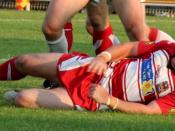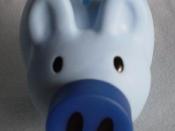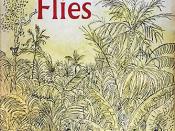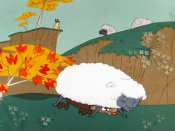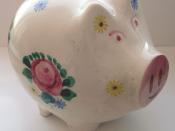The characters that William Golding uses in his Novel Lord of the Flies are full of symbolism. Each of the main characters represents a specific trait that is in each of us. In this novel, he explains the natural instincts that are in all of mankind. He does this by portraying a certain instinct through each of his characters.
Ralph is the character that represents common sense and responsibility. He shows that he has these traits by wanting to build a signal fire. He tells the others, "We've got to make smoke up there"ÃÂor die"ÃÂ (81). Ralph is very optimistic at the beginning of the novel because he believes that his father is going to come and rescue them. Ralph keeps everyone working together by holding meetings and running their community as you would a democracy in which everyone has a say. He also has the good sense to build shelter so that the boys have a place where they can take cover if they need to.
He soon loses his confidence and begins to dream of the past and how things used to be before they ended up on the island. As the story proceeds, Ralph depends more on Piggy's advice and listens to what Piggy has to say. Ralph's common sense is what saved him at the end of the story, and his experience gave him a more mature knowledge of the world. "Ralph wept for the end of innocence, the darkness of man's heart, and the fall through the air of the true, wise friend called Piggy"ÃÂ (202).
Piggy symbolizes intelligence and morality. At first he tries extremely hard to fit in, but fails. The others don't like him because he looks different he has glasses, and he is overweight. Piggy is book smart and understands complex ideas. He has a scientific mind; an example of this would be that he wants to make sundials so that they have some sense of time on the island. He also understands that there could not possibly be beast on the island. Piggy's death and the destruction of the conch symbolize the end of civilization on the island. His death was also like that of a sacrificial pig; "Piggy's arms and legs twitched a bit, like a pig's after it had been killed"ÃÂ (181).
Jack, on the other hand, is irresponsible and acts like a savage. The way that his appearance is described in the novel even implies that he is mean spirited. "His face was crumpled and freckled, and ugly without silliness"ÃÂ (20). Jack develops a lust for violence early in the story. He leads the choir, which becomes the hunters, and takes pleasure in the control and power he has over the group. Jack's knife, which he carries with him everywhere, symbolizes the death and destruction that accompanies his every act. Jack soon wants everyone to be under his command. He lures the boys away from Ralph's command and demands to be chief. Jack is like the devil in the way that he entices the boys to sin. From a psychological viewpoint, Jack is returning to the primitive instincts that we are all born with called id, and he is teaching the other boys that it is all right for them to behave in this manner. It is seen it in the way they dance around the fire chanting, they way they fight and hunt, and the way he leads the boys in a hunt after Ralph. Jack's tribe is lacking civilization of any kind, and the boys return back to their basic instincts.
Roger is the image of evil. He starts out as a quiet and reserved boy, but as the story progresses, he becomes a torturer. Although you can predict that he has an evil streak from the beginning when he throws rocks at one of the littluns, then proves it by killing Piggy with the boulder. He also tortures Samneric until they join the tribe. Unlike Jack, Roger realizes what he is doing is wrong, but he does not care. He performs his treacheries by remaining cool and calm as though he enjoys what he is doing and wants to savor the task. Roger has no conscience, and he is the epitome of evil.
Simon's character resembles goodness; he was the Christ figure in the story. Simon has no fear of the beast. He was like Jesus in the sense that he was the first to recognize that the true evil was coming from within the hearts of boys and not from a beast. "The beast was harmless and horrible; and the news must reach the others as soon as possible"ÃÂ (147). Simon tries to warn the others that there was no beast, but ironically, the boys kill him. Simon dies trying to save them from the evil inside of them, just as Christ died saving us from our sins.
Each of these characters represents a very important aspect that can be found in all of us; the only reason that we do not act this way naturally is because civilization has taught us morals and the difference between right and wrong. Golding uses a lot of symbolism through the characters, and he shows his readers that without the laws created and enforced by civilization, we would revert back to our basic instincts.
